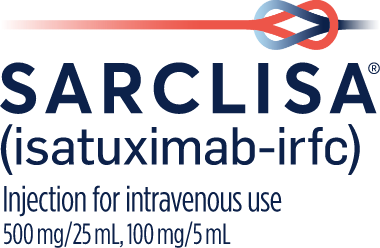FAQS
Frequently asked questions
SARCLISA is a prescription medicine used in combination with:
- The medicines pomalidomide and dexamethasone, to treat adults who have received at least 2 prior therapies, including lenalidomide and a proteasome inhibitor, to treat multiple myeloma
- The medicines carfilzomib and dexamethasone, to treat adults with multiple myeloma who have already received 1 to 3 prior lines of treatment
- The medicines bortezomib, lenalidomide and dexamethasone, to treat adults with newly diagnosed multiple myeloma who cannot receive a type of stem cell transplant that uses their own stem cells (autologous stem cell transplant).
It is not known if SARCLISA is safe and effective in children.
See more about how SARCLISA works.
SARCLISA has been studied in two large Phase 3 clinical trials.
See the results of the SARCLISA clinical trials.
SARCLISA may cause serious side effects, including:
- Infusion
reactions. Infusion reactions are common with SARCLISA and can sometimes be severe or life threatening.
- — Your healthcare provider will prescribe medicines before each infusion of SARCLISA to help decrease your risk for infusion reactions or to help make any infusion reaction less severe. You will be monitored for infusion reactions during each infusion of SARCLISA.
- — Your healthcare provider may slow down or stop your infusion, or completely stop treatment with SARCLISA if you have an infusion reaction.
Get medical help right away if you develop any of the following symptoms of infusion reaction during or after an infusion of SARCLISA:
- —shortness of breath, wheezing, or trouble breathing
- —swelling of the face, mouth, throat, or tongue
- —throat tightness
- —palpitations
- —dizziness, lightheadedness, or fainting
- —headache
- —cough
- —rash or itching
- —nausea
- —runny or stuffy nose
- — chills
- Decreased white blood
cell counts. Decreased white blood
cell counts are common with SARCLISA and certain
white blood cells can be severely decreased. You
may have an increased risk of getting certain
infections, such as upper and lower respiratory
tract infections and urinary tract infections.
- —Your healthcare provider will check your blood cell counts during treatment with SARCLISA. Your healthcare provider may prescribe an antibiotic or antiviral medicine to help prevent infection, or a medicine to help increase your white blood cell counts during treatment with SARCLISA.
- —Tell your healthcare provider right away if you develop any fever or symptoms of infection during treatment with SARCLISA.
- Risk of new cancers. New cancers have happened in people during treatment with SARCLISA. Your healthcare provider will monitor you for new cancers during treatment with SARCLISA.
- Change in blood tests. SARCLISA can affect the results of blood tests to match your blood type. Your healthcare provider will do blood tests to match your blood type before you start treatment with SARCLISA. Tell all of your healthcare providers that you are being treated with SARCLISA before receiving blood transfusions.
The most common side effects of SARCLISA in combination with pomalidomide and dexamethasone include:
- upper respiratory tract infection
- lung infection (pneumonia)
- diarrhea
- decreased red blood cell count (anemia)
- decreased platelet count (thrombocytopenia)
The most common side effects of SARCLISA in combination with carfilzomib and dexamethasone include:
- upper respiratory tract infection
- tiredness and weakness
- high blood pressure
- diarrhea
- lung infection (pneumonia)
- trouble breathing
- trouble sleeping
- bronchitis
- cough
- back pain
- decreased red blood cell count (anemia)
- decreased platelet count (thrombocytopenia)
Heart failure can happen during treatment with SARCLISA in combination with carfilzomib and dexamethasone. Tell your healthcare provider right away if you develop any of the following symptoms:
- trouble breathing
- cough
- swelling of your ankles, feet, or legs
Please see full Prescribing Information, including Patient Information.
SARCLISA is given by a doctor or nurse into your vein as an intravenous (IV) infusion. SARCLISA is given in 4-week, or 28-day, treatment periods called cycles. For the first cycle, SARCLISA is usually given once a week. After the first cycle, SARCLISA is usually given once every 2 weeks.
Learn more about how SARCLISA is given.
CareASSIST from Sanofi helps eligible patients with access and reimbursement, financial assistance, and resource support.
Call 1-833-WE+CARE (1-833-930-2273), Mon – Fri, 9 AM – 8 PM ET, or visit SanofiCareAssist.com/sarclisa.
Learn more about financial assistance for SARCLISA.
Relapse is when multiple myeloma returns after a previously effective treatment.
Refractory is when multiple myeloma is not responding to treatment.
Learn more about previously treated multiple myeloma.
Myeloma cells produce a protein called M-protein. Tests that check for M-protein usually look in the blood or urine. An M-spike, or an increase in the amount of M-protein, can help confirm a diagnosis of multiple myeloma.
Follow-up tests that measure M-protein are also done after treatment begins.
- A decrease in M-protein during treatment may indicate that a treatment is working
- An increase in M-protein (M-spike) that occurs after or during treatment may indicate that multiple myeloma is relapsing or not responding to treatment

